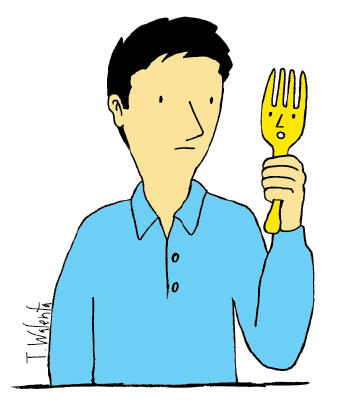The quantified life: In this brave new world, people listen to their forks
Thank goodness Nike is so effective at marketing. Before it started heavily promoting its FuelBand, a black, rubber electronic wristband that tabulates a daily score based on your physical activity, more than a few people asked me if the thing I was wearing on my wrist was a parole bracelet. Nowadays, they tend to know what it is and instead ask, “That’s the Nike thing, right? [Yes.] Do you like it? [Yes.] Is it accurate? [Maybe.] Do you wear it in the shower? [Yes.] Would you take it off for a formal event? [Not if I can earn Fuel points on the dance floor.]”
There’s a lot of curiosity about the wave of gadgets that take the hyper-awareness of our own surroundings — made possible by global-positioning systems and an always-on mobile-data connection — and extend the potential for that awareness to the human body. Previously, this had been of real interest only to those in need of medical monitoring and avid athletes relying on heart-rate watches, altimeters, and lung-capacity tests. The FuelBand — along with other relatively inexpensive and unobtrusive devices like the FitBit and the Jawbone UP, which also measure general physical activity — puts a new mass-market spin on this by telling us that we should be aware of our inner workings, or at least some of them, at all times, not just when we have laced up a pair of running shoes or when our doctors have told us that too many years of eating pizza finally have caught up to us.
As much as the marketing for personal monitoring and consumer-health devices pushes a message of universality — many of these gadgets attempt to appeal to calorie-cutters and ultra-marathoners at the same time — those blinking altimeters affixed to our belts are giving most of us too much information that we really don’t need: the biological equivalent of celebrity news blogs. And the inclusion of social-networking features implies that this should be something we ought to be sharing with our friends, and perhaps even using to compete with them.
This January at the annual Consumer Electronics Show in Las Vegas — the biggest event of the year for anyone who manufactures anything with a battery, an on-off switch, or a power adapter — the most-talked-about device was neither a 3D home-theater system nor a laptop that flips backward to convert into a touchscreen tablet. Instead, it was an import called the “HAPIfork,” a digital fork that monitors how fast you eat so that it can identify potentially unhealthy habits, like eating too quickly or too much. (Of course, this was designed by someone from France.)
The HAPIfork was met at the electronics show with a combination of amusement — comedian Stephen Colbert mocked it on his talk show — and head-scratching. One CEO I spoke to suggested that he certainly wouldn’t want his HAPIfork data getting anywhere near his health-insurance provider. Others suggested that the need to monitor how quickly or slowly you eat was a laughably bourgeois problem. Both reactions reflect an unease with just how much we’re willing to survey our personal habits — though I have no doubt that somewhere out there, there’s someone, or more likely many someones, who saw a Stephen Colbert-skewering of a fork that tells you to get through dinner at a more leisurely pace and wondered, “Why the ridicule? I sure could use that.”
When it comes to self-awareness, we shouldn’t discount the value of listening to plain old biology. Before the advent of personal digital technologies, there were few ways to keep abreast of our inner workings aside from a basic diet, a bathroom scale, or a medical diagnosis. And, generally, we weren’t compelled to go forward with that calorie-counting chart or doctor’s visit until we had some kind of signal that something in our life needed correcting, be it an ache or a pain or an expanding waistline.
So perhaps the important keyword for personal monitoring devices should be “personal,” not “monitoring.” At this point in my life, I don’t think I have the need for a HAPIfork, but I wear my Nike FuelBand because of a sneaking suspicion that, sitting at a desk or in a conference room for the majority of my waking hours, I was much too sedentary on days that I slept through my alarm and couldn’t visit the gym. On these days, lacking that early-morning jolt of energy meant that falling asleep in an afternoon meeting was hardly out of the question. My FuelBand alerts me to the problem: Having a low score light up at noon at the push of a button can be a needed reminder that it’s time for a brisk lunchtime walk.
I wonder how many jet-lagged, bleary-eyed, tech-industry professionals were drawn to the HAPIfork, FitBit, or Jawbone UP on the floor at the Consumer Electronics Show and didn’t understand at first why they found them appealing. Perhaps, if they listened, they would realize it was biology talking after all: “Wouldn’t it be nice to start getting back into shape?”
Caroline McCarthy ’06 is a digital marketer who spent several years as a print and TV journalist covering technology, media, and venture capital.














No responses yet